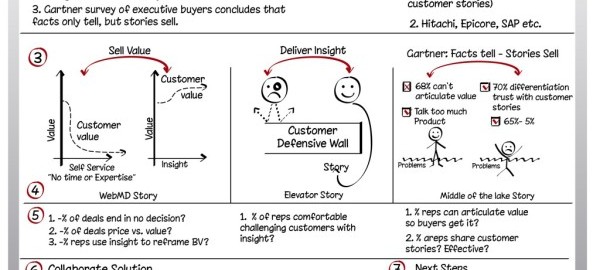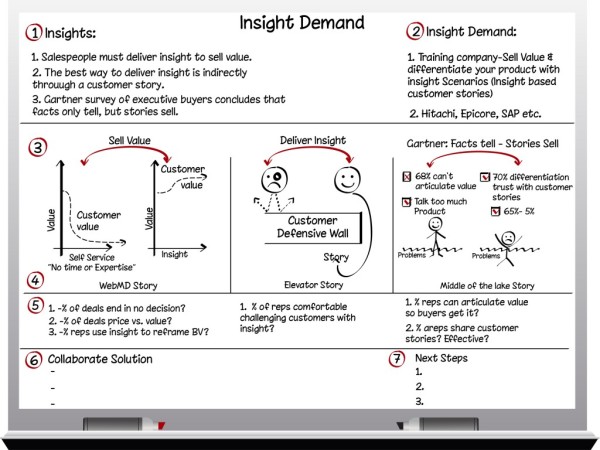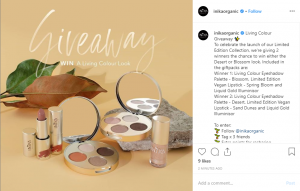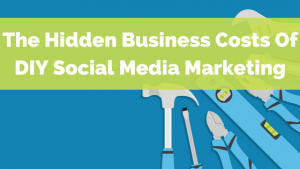Imagine if your salespeople could shine a light of insight on today’s empowered customers so that they no longer underestimate the cost of the status quo and the benefits of change.
Your salespeople would no longer have to chase these empowered buyers down the road of commoditization and discounting, because they would know how to sell value and differentiate your product.
As your customers discovered the unique value of your product on their own terms, your company would achieve higher win rates, shorter sales cycles, and higher margins.
This vision could become a reality if the following three hypotheses are true:
- Salespeople must deliver insight to sell value.
- The best way to deliver insight is through a customer story.
- The executive buyers in Gartner’s survey said that the best way for a salesperson to provide differentiation that they trust is to share a customer story.
Hypothesis 1: Salepeople must deliver insight to sell value.
We’ve all heard that today’s empowered buyers are 60% of the way through a buying cycle by the time they meet a salesperson, because they prefer to do their own research online. But if this self-serve model works so well, then why do 60-70% of enterprise sales opportunities end with the buyer deciding to live with the status quo? Why would a buyer waste all that time and effort only to do nothing?
I believe it’s because buyers lack the time and expertise to form an accurate buying vision on their own. In the interest of expediency, buyers dumb everything down to where all offerings become commoditized, so the only differentiator is price. Unfortunately, what they find is that the dumbed-down version doesn’t solve a problem that they don’t fully understand, so they stick with the status quo or buy the cheapest suboptimal solution.
It’s like when I’m sick. The night before I visit the doctor, I go onto WebMD to figure out what’s troubling me. So by the time I show up at the doctor’s office, I am just looking for him to write me a prescription. Sure, the doctor could have tried to influence me online through blogs, etc., but like buyers today, I don’t have the time or expertise to become a doctor online overnight. So, I need the doctor to shine a light of insight on my incomplete buying vision so that it more closely represents the truth.
Admittedly, for less complex products, I believe buyers can successfully buy online, because they can form an accurate buying vision on their own. But for complex products, I believe salespeople must shine the light of insight on the buyer’s incomplete buying vision so that they can fully appreciate the value of your product.
Questions for you to consider:
- What percent of your sales opportunities end in no decision?
- What percent of your deals are based on price vs. value?
- What percent of your salespeople use insight to reframe the customer’s buying vision?
Hypothesis 2: The best way to deliver insight is through a customer story.
Even though insight may be what buyers need, it may not be what they initially want. By the time a buyer engages with a salesperson, for instance, they may already have an idea of their needs, the solution they believe they want, and what they are willing to pay. So it’s difficult to directly deliver your insight to these buyers, because it will just bounce off of their established filter of what they believe they need. It can also come across as an attack and make the buyer feel badgered or manipulated.
Imagine, for example, that it’s 8:30 a.m. on a Tuesday, and your rep is riding the elevator up to the 35th floor to meet one of your largest prospects. They’re about to sit down with a C-level executive with 20 years of experience at the boardroom table, and your 26-year-old rep is going to deliver insight about the error of their ways. How do you think that conversation is going to go? I call that the black eye and bloody nose approach.
An alternative approach is to wrap your sales insight up in a customer story. Because the message isn’t directed at them personally, buyers are less likely to see the insight as an attack, feel offended, and shut down. It’s like putting your sales insight inside a Trojan horse so that it makes it past the buyer’s defensive wall.
Question for you to consider:
1. What percent of your salesforce is comfortable challenging customers with insights?
Hypothesis 3: Gartner’s survey of executive buyers concludes that facts tell but stories sell.
In the Gartner survey, 74% of executive buyers felt salespeople spend too much time talking about their product. But without the context of a story, salespeople are leaving it up to the customer to figure out why they should buy their product. This product strategy is not successful, because only 34% of executive buyers felt salespeople could articulate value. If salespeople want to sell value, 70% of executive buyers said that the best way for salespeople to provide differentiation that they trust is by sharing customer stories.
I can remember how excited I was to finally be able to afford to hire a salesperson with more industry expertise than anyone our team. But after three months, he wasn’t getting any traction with customers. So one afternoon I asked him how his meeting went. He said, “You can lead a horse to water, but you can’t make it drink.” I said, “I can send someone from telesales to do that. Your job is to make them thirsty.”
He gave me a blank stare, so I decided to use a metaphor: “Right now, you’re like a rescue boat salesman, trying to rescue customers who are only ankle-deep in problems. No wonder they are clipping you at the knees, because they’ve got no skin in the game. Instead of giving them a lecture on our product, why don’t you tell them a customer story that packs so much insight that they realize they’re not ankle-deep, but that they’re out in the middle of the lake drowning in problems before you try to rescue them with your product? That’s when they’re ready to believe in the viability of our product, not before. “
So not only do stories help customers to internalize the value of being rescued by your product, but they are also 12X more memorable than facts. In one Stanford University study, for example, only 5% of the audience remembered facts, but 63% remembered stories.
Questions for you to consider:
1. What percent of your salesforce can articulate value and help your customers to get it?
2. What percent of your sales team share customer stories? Are they effective?
Hypotheses: True or False?
I believe these hypotheses are true, because without providing insight scenarios to today’s empowered buyers, salespeople are forced to follow the customer down the path of commoditization and discounting.
Business Articles | Business 2 Community
(433)
Report Post





